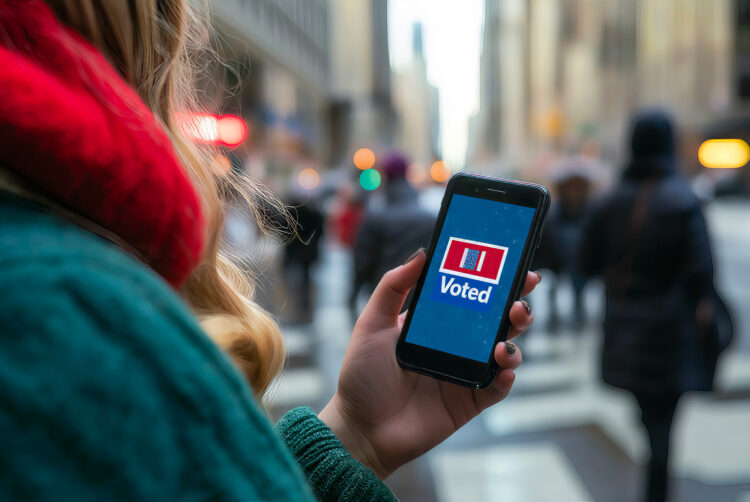Our political future starts with the smartphone

Opinion
The most valuable thing we can offer is a neutral, informative space amongst the noise, writes Snap’s UK creative strategy chief.
By the time this year is over, more than half of the world’s population will have had a major election in their country. The next, and arguably most globally impactful, needs no introduction.
A remarkable 41m Gen Z voters will be eligible to vote in next month’s US election, making them one of the largest unknown influences in the presidential race. This is a demographic that is impressively politically aware — 70% of Gen Z are involved in a social or political cause — and yet they are increasingly disillusioned with the political system. In the 2022 midterms, just 28% of 18- to 24-year-olds turned up to the ballot box.
But when the single biggest moment of the presidential election continues to be on terrestrial TV, a medium which is rapidly losing young viewers, why should we expect them to be engaged?
The key to engaging the next generation of voters in democratic process lies right at our fingertips, or in our pockets.
Fortunately, publishers are catching on just in time for the most politically consequential year in decades.
Bringing the iPhone to IRL
Gen Z are driven to action by their smartphone on an almost daily basis.
More than eight in 10 have been persuaded to make a purchase by influencer content. They socialise, shop, search, read, and learn, all on their phones. The term “digital native” may be overused, but for this generation who has never known life before the smartphone, their on-screen life is inseparable from in-person.
Just this month, CBS marked a critical shift in its normal debate coverage when it introduced a fact-checking QR code for the vice presidential face off. When 84% of adults watch television with a second screen, the QR code brought viewers a way to engage more deeply with the issues being discussed on screen in real time, meeting CBS’s audience exactly where they are.
To change behaviour, you have to understand behaviour. I’ve seen the power of this myself.
In the UK, the electoral commission prompts voters to register using letters, emails, and a 30-second ad to air on terrestrial and streamed TV. But how well does that square up with the typical young person’s lifestyle?
At Snapchat, we had an opportunity to mobilise and educate the 90% of 13-24 year-olds active on our platform during the recent General Election. In partnership with My Life My Say, a youth-focused voter registration non-profit, we created a new Augmented Reality lens to launch ahead of National Voter Registration Day.
The lens allowed users to visualise themselves within the democratic process by casting their vote at the ballot box. Specially designed stickers empowered voters to share the issues impacting them most, including housing and education, with all of their friends — alongside a link to register to vote.
The campaign saw 1.64 million voter registrations across 18- to 34-year-olds, with just under half of these being Gen Z users.
Making democracy shareable
Its overwhelming success could be attributed to a few behavioural factors. The stickers helped users engage with the reality of the election, personalising their Snaps to proudly show the causes they care most about and convincing their friends in the process.
In general, the lens made registering to vote an inherently social act, in line with so much of our digital lives. As users shared My Life My Say’s message with their trusted friends and family, they encouraged an incredible 3,000 people to register to vote every five minutes through the link.
Research from Deloitte has shown that Gen Z are most motivated by self-expression and socialising.
Civil action is one of the most powerful forms of self-expression, and as the not-for-profits and media publishers of the world embrace the evolving media landscape, they will continue to empower more voters to bring their peers along with them.
The last and most powerful part of the campaign lay in the neutrality of the lens. Users were simply encouraged to register and share, and they did so in their thousands.
Political spaces, both online and in print, have become increasingly divisive. But politics is intensely personal, and the most valuable thing we can offer is a neutral, informative space amongst the noise. Besides, Gen Z don’t need to be told what to believe, nor do they need to be talked down to. These voters just needed a helping hand to act.
This isn’t just true for Gen Z. So many of us have become used to a level of convenience and hybrid experiences, whether we’re shopping for a new outfit or clocking in for work. We use our smartphones to stay in touch with loved ones, we use our online profiles to express ourselves and our values, we all scroll along to TV shows, even the ones we’ve been desperate to watch.
It’s time for our most important processes to tap into the platforms and behaviours that shape daily life, meeting all voters exactly where they are — online and engaged.
 Kate Mellett is head of UK Creative Strategy, Snap Inc
Kate Mellett is head of UK Creative Strategy, Snap Inc




